
TB 9-6625-2337-35
(14) Verify that the pulse displayed on channel 2 is approximately coincident with
the pulse on channel 1.
(15) Connect the probe tip to pin 12 of the UUT connector.
(16) Press TI keys as listed in (a) through (e) below.
(a)
Use the arrow keys to highlight VP1, ENTR (OFF).
(b)
Use the arrow keys to highlight VP2, ENTR (ON).
(c)
Use the arrow keys to highlight VP2 DLY:.
(d)
100, ENTR.
(e)
Use the arrow keys to highlight VP1/VP2:, ENTR (YES).
(17) Verify that the pulse displayed on channel 2 is approximately coincident with
the pulse on channel 1.
(18) Verify that the pulse width of the signal on channel 1 is within limits listed in
first row of table 9.
(19) Press TI keys as listed in (a) and (b) below:
(a) Use the arrow keys to highlight VP2 PW:.
(b) .25, ENTR.
(20) Verify that the pulse width of the signal on channel 2 is within limits listed in
second row of table 9.
(21) Repeat technique of (19) and (20) above for remaining row in table 9.
TI
Oscilloscope
VP2 pulse
Measurement
Test description
width
type
Minimum
Maximum
.95 s
1.05 s
VP1/2 1 s Pulse Width
----------
Channel 1
Width
0.2 s
0.3 s
VP1/2 .25 s Pulse Width
.25 s
Channel 2
Width
9.95 s
10.05 s
VP1/2 10 s Pulse Width
10 s
Channel 2
Width
(22) Disconnect X1 probe from UUT and oscilloscope channel 1 input. Connect TI
termination.
(23) Press TI keys as listed in (a) through (i) below:
(a)
Use the arrow keys to highlight VP1, ENTR (ON).
(b)
Use the arrow keys to highlight VP1 PW:.
(c)
0.5, ENTR.
(d)
Use the arrow keys to highlight VP1 DLY:.
(e)
10, ENTR.
(f)
Use the arrow keys to highlight VP2 PW:.
(g)
0.5, ENTR.
(h)
Use the arrow keys to highlight VP2 DLY:.
(i)
1, ENTR.
CHANGE 1 17

